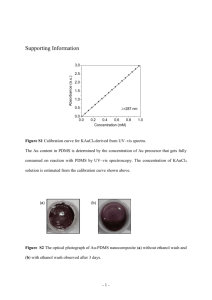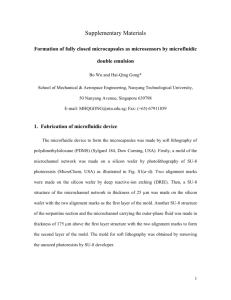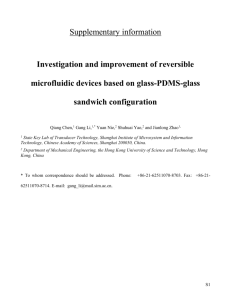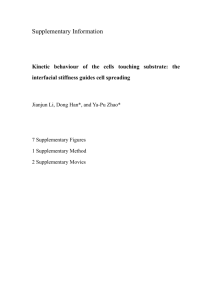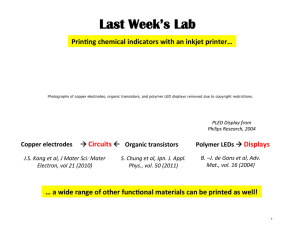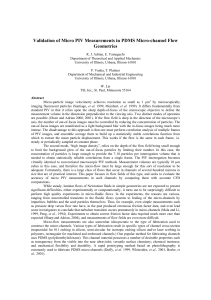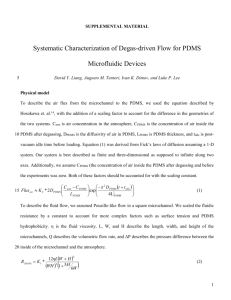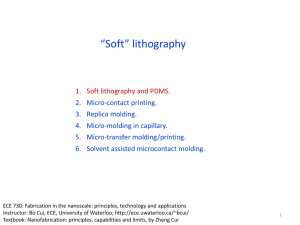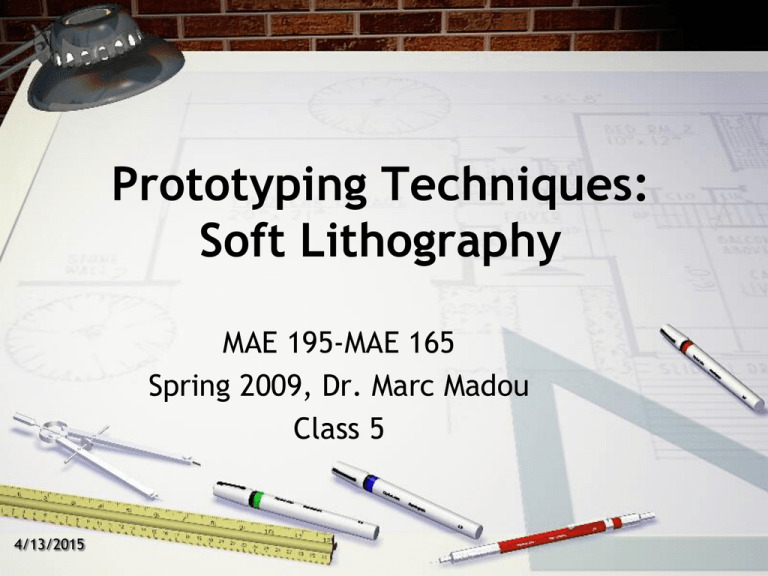
Prototyping Techniques:
Soft Lithography
MAE 195-MAE 165
Spring 2009, Dr. Marc Madou
Class 5
4/13/2015
What is Soft Lithography?
• Molding of a polymer (usually PDMS) using a
photoresist master mold
• Fast, cheap prototyping method
• Device features limited only by the
complexity of master mold. Down to 10 nm
feature resolution.
4/13/2015
PDMS (Polydimethylsiloxane)
• Silicon-based
elastomer
• Mix the two
components for
various amounts
of cross-linking
• Hydrophobic
surface
4/13/2015
Properties/Benefits
Property
Characteristics
Consequence
Optical
Transparent
Optical detection from 240 to 1100
nm
Electrical
Insulating, breakdown voltage,
2 x 10 E7 V/m
Allows embeded surfaces,
Intentional breakdown to open
connections
Mechanical
Elastomeric, high youngs
module ~70 kPa
Conforms to surface when not
polymerized, reversible
deformation
Thermal
Insulating, thermal conductivity
of 0.2 W/(m.k)
can be used to insulate heated
solutions
Properties/Benefits
Property
Characteristics
Consequence
Interfacial
low surface free energy
20 erg/ cm2 (0.02 J/m2)
replicas release easily from molds;
can be reversibly sealed to
materials
Permeability
impermeable to liquid water;
permeable to gases and
nonpolar organic solvents
contains aqueous solutions in
channels
Allows gas transport
Incompatible with many organic
solvents
Toxicity
Non toxic
Can be implanted in vivo
Reactivity
Inert, can be oxidized by
exposure to plasma
Unreactive toward most reagents;
can be modified to hydrophilic and
reactive towards silanes
PDMS device Applications
Configurable
Gradient Generator
Valving via electrical
breakdown of PDMS
Generation of Gradients Having Complex Shapes Using
Microfluidic NetworksStephan K. W. Dertinger,, Daniel T. Chiu,,
Noo Li Jeon, and, George M. WhitesidesAnalytical Chemistry
2001 73 (6), 1240-1246
Cell patterning through
surface modifications
Fabrication of a Configurable, Single-Use Microfluidic
Device, McDonald, J. C.; Metallo, S. J.; Whitesides, G. M.
Anal. Chem. 2001,73, 5645-5650
SolidWorks Design
A system of channels and reservoirs is designed in a CAD software.
SolidWorks Design
Deep and shallow features are separated
SolidWorks Design
SolidWorks Design
The design is saved in a DXF file format and sent to the printing company
Photoresist Mask
A commercial printer uses the CAD file to produce a high-resolution transparency
Fabrication of the mold (Photolithography)
•
•
•
•
•
•
•
•
Clean the silicon wafer and dry
Spincoat a thin layer of SU-8
photoresist
Soft bake to evaporate the solvent.
Align the mask
Flood exposure to UV light
Hard bake to cross-link the exposed
portions of he photoresist film
Develop to wash away the non-exposed
area of the photoresist
Rinse with Isopropenol and dry with
nitrogen gun
Silicon
photoresist
mask
Rapid Prototyping
•
A system of channels is designed in a CAD
program.
•
•
A commercial printer uses the CAD
file to produce a high-resolution
transparency
•
This transparency is used as a photomask
in contact photolithography to produce a
master.
A master consists of a positive relief of
photoresist on a silicon wafer and serves as
a mold for PDMS.
Liquid PDMS pre-polymer is poured over
the master and cured for
1 h at 60 °C. (C) The PDMS replica is
peeled from the master
(D) the replica is sealed to a flat surface to
enclose the channels.
•
•
•
•
•
Soft Lithography Techniques
• Soft lithography includes several techniques such as:
•
•
•
•
Replica Molding (REM)
Micro-contact printing (µCP)
Micro-transfer molding (µTM)
Micro-molding in capillaries (MIMIC)
Replica Molding (REM)
•
Master mold is replicated in PDMS
by casting and curing PDMS prepolymer.
•
PDMS mold is oxidized in oxygen
plasma for 1 minute and exposed
to fluorinated silane for 2 hours to
make a surface with low adhesion
to PDMS.
•
PDMS is cast against this negative
replica, cured and peeled off.
•
This will make the positive replica
of the original master.
Micro-Contact Printing (µCP)
•
It uses a PDMS stamp to form patterns
of self-assembled monolayers (SAMs) on
the surfaces of substrates.
•
PDMS stamp is coated with an ink of
the molecules and pressed onto the
solid surface
•
Inking creates a Self Assembled
Monolayer on the solid surface
•
the use of elastomers allows the
micropatterned surface to come into
conformal contact with the surfaces
over large areas
Micro-Transfer Molding (µTM)
•
PDMS stamp is filled with pre
polymer
•
Excess prepolymer is removed
•
Press the rubber stamp against
the surface
•
Cure the polymer
•
Peel off the stamp
Micromolding in Capillaries (MIMIC)
•
Push the PDMS stamp against the
substrate.
•
prepolymer is applied to access holes
in the mold (vacuum assisted).
•
Prepolymer fills the channels using
capillary forces.
•
Cure the polymer
•
Peel off the PDMS mold


